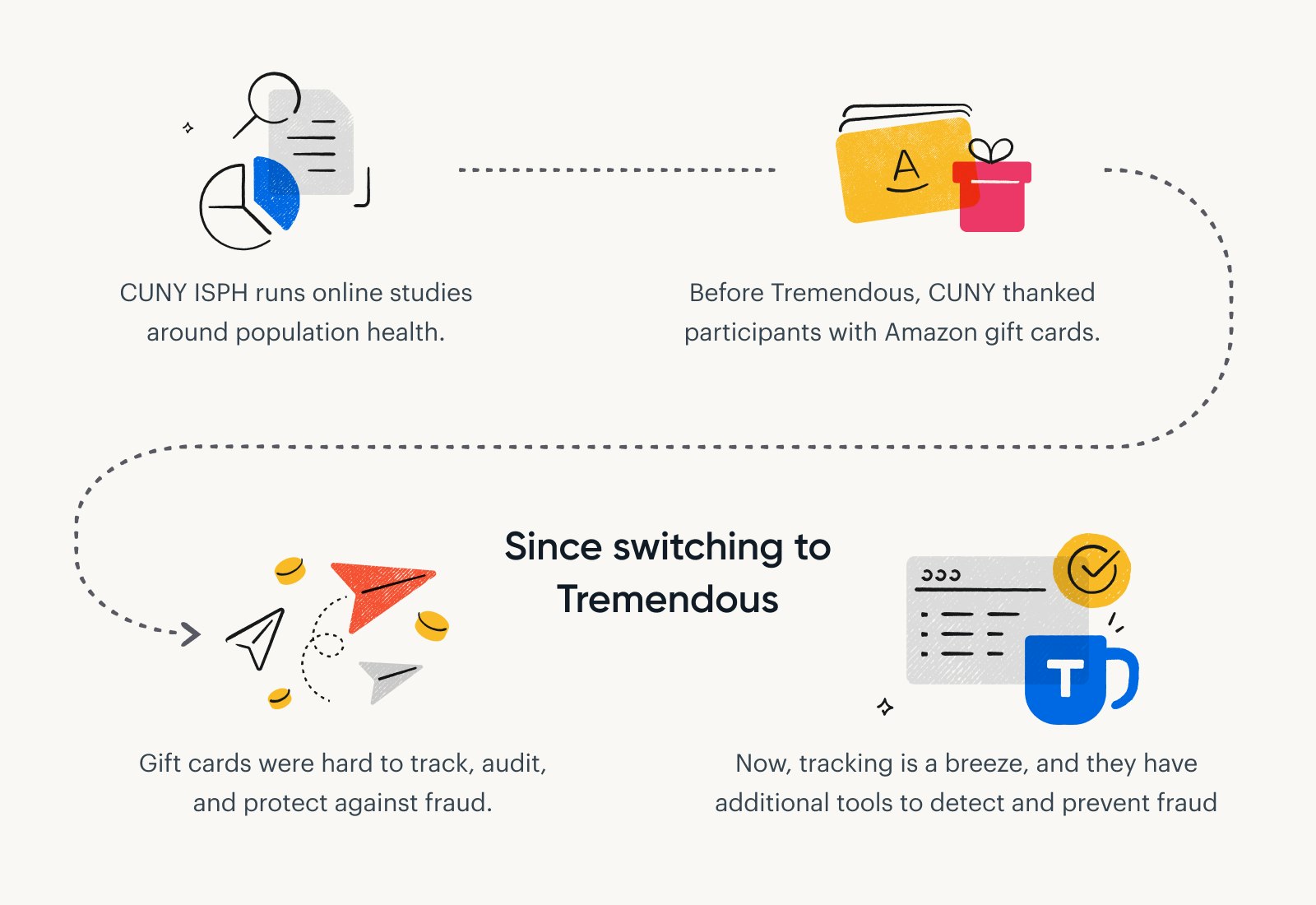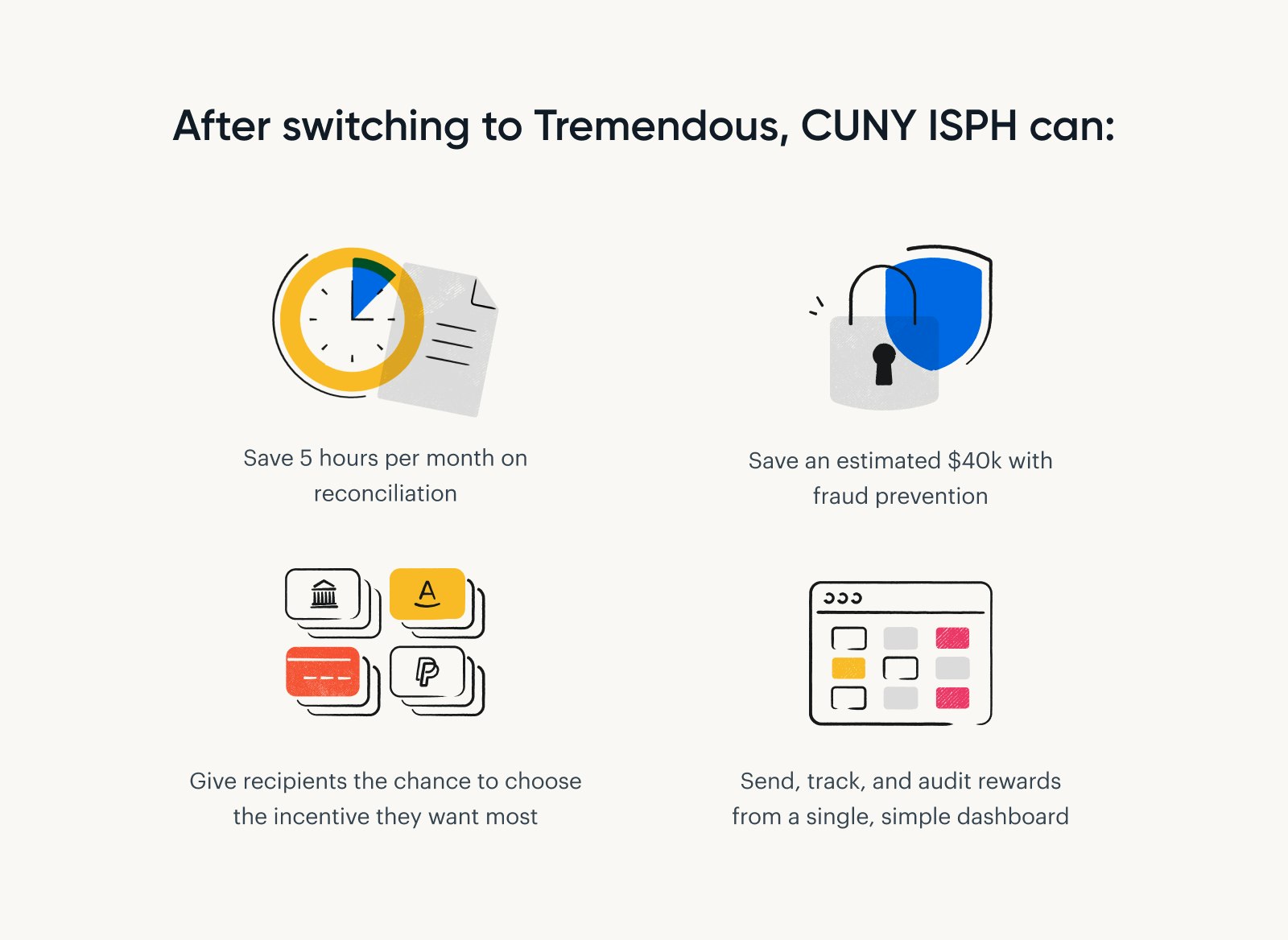The City University of New York saves $40K with fraud prevention
"There’s so much we wouldn’t have caught if it wasn’t for Tremendous’ fraud prevention features."

Highlight reel
For over a decade, CUNY ISPH has run longitudinal online studies to improve population health. The institute is a leader in recruiting and retaining large online national cohorts.
Before Tremendous, ISPH compensated participants with digital Amazon gift cards or physical gift cards.
These methods were hard to track. And it was difficult to audit gift codes in a way that was secure and compliant. Plus, CUNY had limited fraud prevention measures and little recourse if the codes were hacked.
Since switching to Tremendous, CUNY can meet compliance standards, track rewards, and audit incentives from a single dashboard. And it’s much easier to monitor and stop fraud.
"We've probably saved $40,000 as a direct result of the fraud features so far. And that's real money.”
The problem
City University of New York (CUNY) Institute for Implementation Science in Population Health (ISPH) hosts a longstanding and robust research program. The Institute has been recruiting research participants and carrying out surveys online for longitudinal studies for more than 10 years.
CUNY is a leader in online studies. But for years, the way they incentivized participants for their time was less than ideal.
“We used Amazon gift cards,” said Sarah Kulkarni, Associate Director at ISPH CUNY. “But there were a variety of problems with that, particularly for informal audits and compliance. Those processes were time-consuming and manual.”
CUNY was moving millions of dollars via Amazon gift codes. While recipients loved the breadth of offerings available through Amazon, Sarah and her team wanted a more secure way to send incentives.
“There was always a gnawing concern around whether the codes would get hacked,” she said.

In 2022, a researcher on the CUNY ISPH team who had been using Tremendous for a small study recommended that Sarah try the platform.
“We investigated, and we were really impressed with the platform — not just from an audit and compliance perspective, but also the transparency of the product,” Sarah said. “I liked that I could move between projects and see where the money was.”
In 2024, they integrated with the Tremendous API.
“Now, it’s automatic,” said Kate Penrose, Project Director at CUNY ISPH. “Our participants use a platform to complete activities related to the study, and then their incentives are automatically triggered when they’re done.”
Most of CUNY’s research consists of large-scale projects, so they often send more than $1M in incentives for a single study. But they use Tremendous for projects of all sizes.
“We’ve used it for everything ranging from one-off in-depth interviews to paying 5,000 people,” said Sarah.
Fraud prevention. At scale.
Almost immediately after they activated Tremendous’ fraud prevention feature, Sarah, Kate, and their team began receiving alerts in the platform.
“We’re giving out sizable incentives for these long-term studies, so we’re definitely a target for fraud,” said Sarah.
While Kate, Sarah, and their team knew fraud was an issue before using the tool, they didn’t realize how formidable the problem had become.
“We have our own algorithms that flag people who are doing suspicious things in surveys,” said Kate. “But there’s so much we wouldn’t have caught or wouldn’t have caught as quickly if it weren’t for Tremendous’ fraud prevention features. Being able to integrate the Tremendous features into our existing algorithms make them even more powerful.”
Hackers and fraudsters are getting more advanced in their tactics. So the fraud prevention feature includes multiple layers of security measures, which flag fraudsters across several vectors, including participants previously declared fraudulent in another study across the entire Tremendous network.
"We had someone trying to hack us and claim $7,500 worth of incentives,” said Sarah. “But thanks to the fraud prevention feature, we realized that we had a problem quickly and were able to stop it.”
Fraud is a problem industry-wide. But in the few months since activating fraud prevention, CUNY ISPH has been able to breathe a sigh of relief.
“We've probably saved $40,000 as a direct result of the fraud feature so far, both in incentives and study materials,” said Sarah. “And that's real money.”
Reconciliation made simple
Before switching to Tremendous, tracking when and where CUNY researchers sent incentives was a complicated, multi-step process.
“With gift reward codes, we’d have to track where the codes went and set up a repository to store them,” said Sarah. “We had a local database in Access or Excel where we tracked rewards, but everyone tracked them a little differently.”
This made reconciliation a painstakingly manual process.
With Tremendous, Sarah no longer has to track down and retrieve rewards across Excel spreadsheets. The platform automatically tracks all rewards for her. And she can view all incentives sent across every CUNY account in a single dashboard.
“Reconciliation is so much easier,” said Sarah. “It’s perfect. We probably save four or five hours every month on reward tracking and reconciliation alone.”
The outcome
The studies CUNY ISPH runs are complex, nuanced, large-scale, and long-term. There are dozens of moving parts and hundreds of potential problems that can crop up at any point in the multi-year process of conducting a longitudinal research study.
Now, incentives are one less thing CUNY ISPH has to worry about.
“This is a really complicated study, and when I say Tremendous is the least complicated part of this study, I mean it,” said Sarah.
Before Tremendous, all research participants received the same incentive. Now, they can choose what they want most.
“Having the ability to donate to charities has been really nice,” said Kate. “Some people in our studies don’t want an incentive at all. They just want to contribute to science. But they feel great about donating their incentive.”
And as CUNY ISPH grows, they know the platform will grow with them.
“I learned how to use it in about 10 minutes,” said Sarah. “Whenever I have a call to train someone new on how to use it, it’s a 3 minute Zoom call. It’s my favorite call of the week.”
“I learned how to use [Tremendous] in about 10 minutes. Whenever I have a call to train someone new on how to use it, it’s a 3 minute Zoom call. It’s my favorite call of the week.”
Research (population health)
50-200 employees
Gift Cards